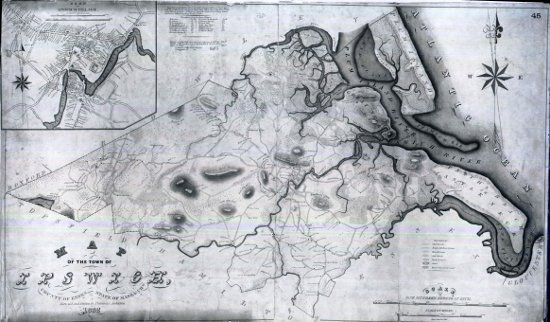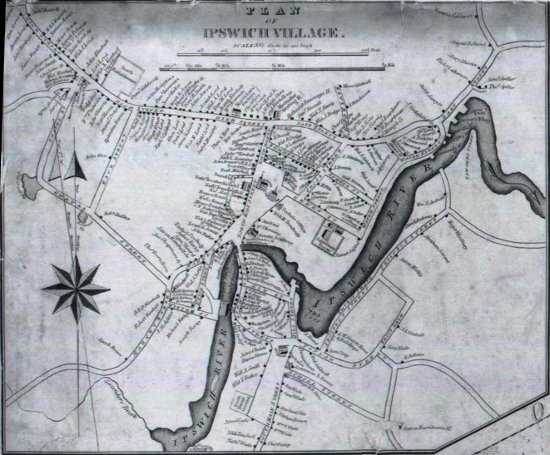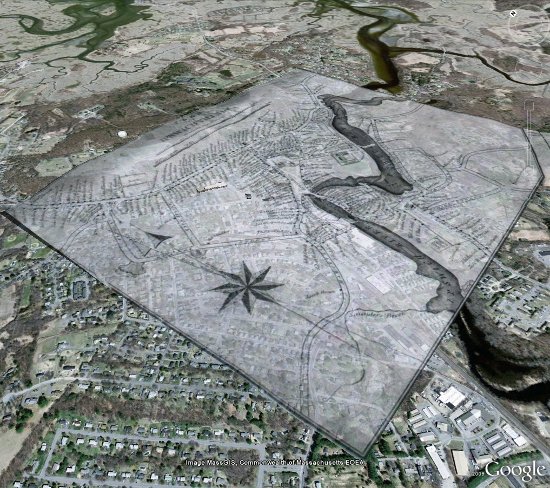Ipswich, Massachusetts 1832
A map of Ipswich Massachusetts by Philander Anderson.
Notice that the current Washington Street is called Gravel Street, which follows the path of the current Liberty Street to Lord Square. The current Mineral Street is called Back Street here. Gravel Street takes its name from the two open gravel pits depicted on the map, one at the corner of Back Street and the other at the turn of what is now Liberty Street.
A KMZ file viewable in Google Earth is of the village inset map is available here.
This map can also be seen directly in Google Maps using a normal browser here.

A Short History of the Word “The” (Part 2)
This continues some earlier notes I had made on the etymology of the word “the”.
Old English is the earliest attested progenitor of modern English, so any earlier etymologies can only be done by comparing other related languages and reconstructing forms through the application of morphology rules. English is a Germanic language related to German, Dutch, Norse and Icelandic. The common ancestor of these languages is known as Proto-Germanic (PGmc)
Ringe (2006) has given the paradigm shown below. Notice that it has the same s- in the masculine and feminine nominative singular, and þ- for all other forms, as in Old English.
| Masculine | Feminine | Neuter | |
|---|---|---|---|
| Singular | |||
| Nominative | sa | sō | þat |
| Accusative | þanǭ | þǭ | þat |
| Dative | þammai | þaizōi (?) | þammai |
| Genitive | þas | þaizōz | þas |
| Instrumental | þana (?) | þaizō | þana (?) |
| Plural | |||
| Nominative | þai | þōz | þō |
| Accusative | þanz | þōz | þō |
| Dative | þaimaz | ||
| Genitive | þaizǭ | ||
| Instrumental | þaimiz |
Things become more speculative reaching back to Proto-Indo-European. While there is general agreement that the stem of the demonstrative pronoun is so/to, the full inflection is more uncertain. The system given most often is that proposed by Beekes (1995). His is based on the theory put forward by Lane (1961). Given the many forms of the demonstratives among daughter languages, an inflection system based on the standard method of comparison would produce an unrealistic number of stems. Lane identified a fundamental mechanism within PIE of binding a number of standard particles to a basic stem. The most familiar example of this general PIE mechanism is the development of the word “this”: The OED gives the etymology as a Norse and West Germanic formation, produced by adding se, si (from Gothic, sai ‘see, behold’) to the simple demonstrative represented by “that”, as shown by the early Old Norse runic forms, sá-si, sú-si, þat-si. Later the compound was felt as a single word and inflected at the end.
Beekes applied a similar approach, though with a different set of particles and updated with the application of laryngeal theory.
Notice though that while PIE has a larger inflection system, like PGmc, it has the same s- in the male and female nominative and t- for the neuter and all other oblique forms.
| Masculine | Feminine | Neuter | |
|---|---|---|---|
| Singular | |||
| Nominative | so | seh2 | tod |
| Accusative | tom | teh2m | tod |
| Dative | tosmoi | tesieh2ei | |
| Genitive(to)sio | (t)eseh2s | ||
| Ablative | tosmod | ||
| Locative | tosmi | tesieh2i | |
| Instrumental | toi (?) | toi (?) | |
| Plural | |||
| Nominative | toi | seh2i (??) | teh2 |
| Accusative | tons | teh2ns | teh2 |
| Dative | toimus | teh2mus? | |
| Genitive | tesom (?) | tesom (?) | |
| Ablative | toios (?) | ||
| Locative | toisu | teh2su (?) | |
| Instrumental | toibʰi | teh2bʰi (?) |
Attempts have been made to find relationships between PIE and other language families. Greenberg (2002) has proposed “Eurasiatic” that groups PIE with languages as diverse as Korean, Japanese and Eskimo-Aleut.
Interestingly there is similarity between the PIE demonstrative root and the constructed ancestors of other members of this proposed group. E.g.:
| Yukaghir | Uralic | Indo-European |
|---|---|---|
|
tiŋ (Tundra), tuŋ (Kolyma) ‘this’; taŋ ‘that’ |
*tä ‘this’ (eg. Finnish tä-mä); *to ‘that’ (eg. Estonian too) |
*to- ‘this, that’ |
Greenberg gives a general demonstrative stem of *tV, that is, “t” followed by some vowel.
| *tV |
Once etymologies get this deep, the standard linguistic tools begin to break down. The best that could probably be done would be to perform mathematical analysis which assigns a level of correlation and generates possible forms.
If this reconstructed stem is accurate, that “t” at the beginning of our word “the” goes back nearly 15,000 years.
Notes
[1] Ringe, Donald A., From Proto-Indo-European to
Proto-Germanic. 2006, p. 288-289.
[2] Mallory J. P.; Adams, Douglas Q., The Oxford
Introduction to Proto-Indo-European and the Proto-Indo-European World. 2006, p. 417-418.
[3] Lehmann, Winfred P., Theoretical Bases of Indo-European
Linguistics. 1996, p. 158-159.
[4] Beekes, Robert S. P., Comparative Indo-European
Linguistics. 1995, p. 201-204.
[5] Lane, George S., On the Formation of the Indo-European Demonstrative. Language, Vol. 37, No. 4 (Oct. - Dec.,
1961), pp. 469-475.
[6] Greenberg, Joseph H., Indo-European and its Closest
Relatives: The Eurasiatic Language Family, Vol 1. 2000, p. 94-101.




